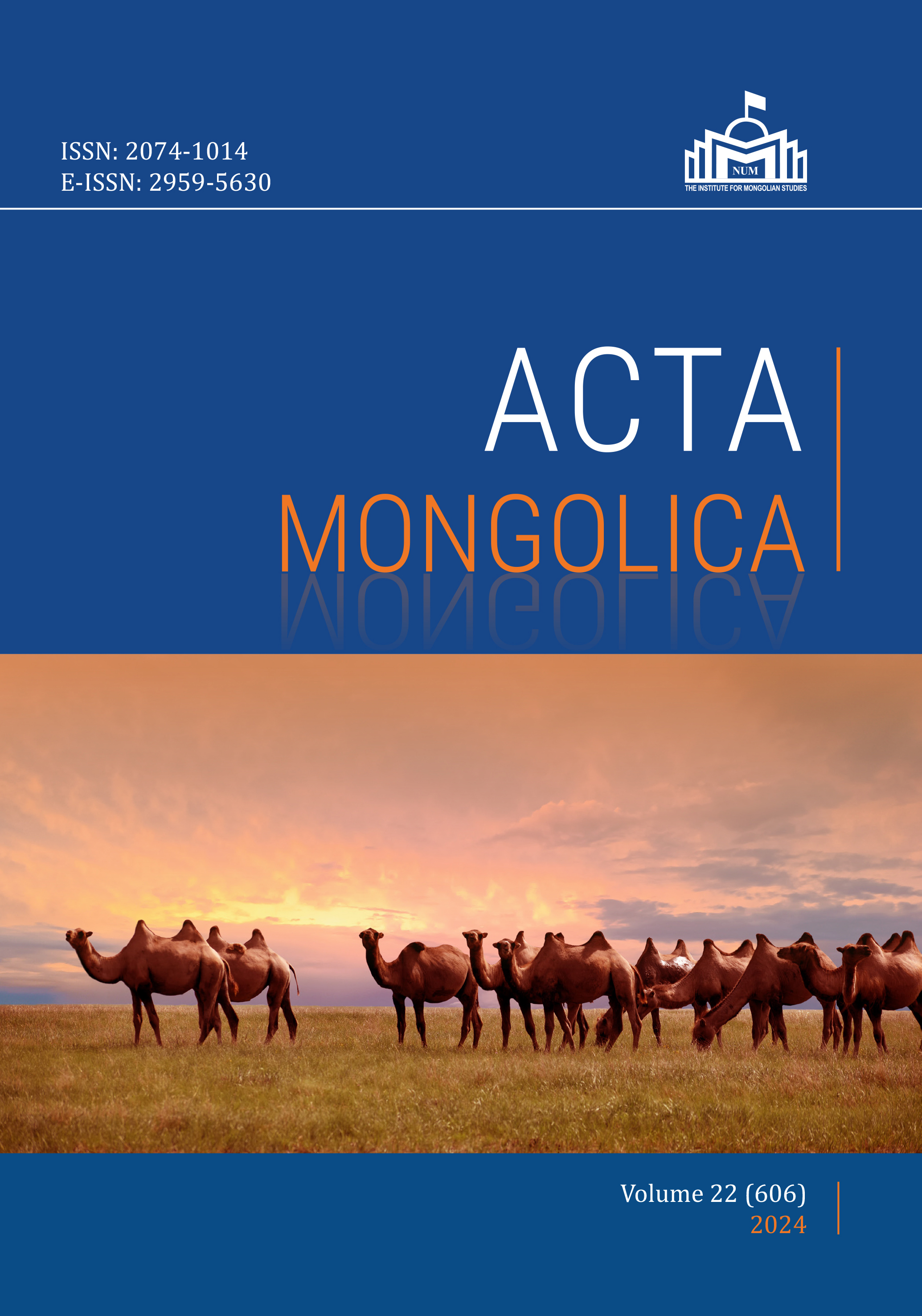Reduced Embedded Questions with Multiple Wh-phrases in Chakhar Mongolian
Main Article Content
Abstract
This paper provides a detailed description of reduced embedded questions with multiple wh-phrases in Chakhar Mongolian and proposes to analyze them in terms of a reduced cleft analysis. We argue that reduced questions with multiple wh-phrases in Chakhar Mongolian can be directly derived by applying subject ellipsis, which is independently allowed in Chakhar Mongolian, to presuppositional clauses of embedded multiple cleft sentences. Our proposal is supported by observations that reduced questions and multiple cleft construction in Chakhar Mongolian exhibit parallel properties, including case-marked wh-phrases and adherence to the clause-mate condition.
Article Details

This work is licensed under a Creative Commons Attribution-ShareAlike 4.0 International License.
References
Abels, Klaus, and Veneeta Dayal. 2023. On the syntax of multiple sluicing and what it tells us about wh-scope taking. Linguistic Inquiry 54.3: 429–477. https://doi.org/10.1162/ling_a_00448
Bai, Xue, and Daiko Takahashi. 2023. A pseudo-sluicing analysis of reduced embedded questions in Chakhar Mongolian. Journal of East Asian Linguistics 32: 497–522. https://doi.org/10.1007/s10831-023-09264-8
Bai, Xue. 2023a. Reduced embedded questions in Uyghur. Journal of International Cultural Studies 29: 171–188.
Bai, Xue. 2023b. A comparative study on Chakhar Mongolian and Japanese matrix sluicing. To appear in Proceedings of the 16th Workshop on Altaic Formal Linguistics. Cambridge, MA: MIT.
Bai, Xue. 2023c. An exploration of multiple sluicing from a cross-linguistic perspective. Doctoral dissertation, Tohoku University.
Bao, Lina. 2014. Mongorugo niokeru bunretsubun no kenkyuu: Zokukakushugo ninka shisutemu eno shisa [A study of the cleft construction in Mongolian: Implications to the system of genitive subject licensing]. Nihongo Nihonbunka Kenkyu 24: 24–35.
Bao, Lina, Hideki Maki, and Megumi Hasebe. 2015. Three case alternation mysteries in modern Mongolian. In Essays on Mongolian syntax, ed. Hideki Maki, Lina Bao, and Megumi Hasebe, 43–54. Tokyo: Kaitakusha.
Binnick, Robert I. 1979. Modern Mongolian: A transformational syntax. Toronto: University of Toronto Press.
Cortés Rodríguez, Álvaro. 2023. Multiple sluicing through an experimental lens: Amelioration effects, crosslinguistic variation, and processing. Doctoral dissertation, University of Tübingen.
Fong, Suzana. 2019. Proper movement through Spec-CP: An argument from hyperraising in Mongolian. Glossa: a journal of general linguistics 4: 1–42. https://doi.org/10.5334/gjgl.667
Gong, Zhiyu Mia. 2022. Case in wholesale late merger: Evidence from Mongolian scrambling. Linguistic Inquiry: 1–66. https://doi.org/10.1162/ling_a_00494
Grano, Thomas, and Howard Lasnik. 2018. How to neutralize a finite clause boundary: Phase theory and the grammar of bound pronouns. Linguistic Inquiry 49.3: 465–499. https://doi.org/10.1162/ling_a_00279
Gribanova, Vera. 2013. Copular clauses, clefts, and putative sluicing in Uzbek. Language 89: 830–882. https://doi.org/10.1353/lan.2013.0074
Guntsetseg, Dolgor. 2012. Differential case marking in Mongolian. Doctoral dissertation, University of Stuttgart.
Hashimoto, Kunihiko. 2006. The third person proclitic as topic/focus markers in Mongolian. Cognitive Studies 4: 7–23.
Hiraiwa, Ken, and Shinichiro Ishihara. 2012. Syntactic metamorphosis: Clefts, sluicing, and in-situ focus in Japanese. Syntax 15: 142–180. https://doi.org/10.1111/j.1467-9612.2011.00164.x
von Heusinger, Klaus, Udo Klein, and Dolgor Guntsetseg. 2011. The case of accusative embedded subjects in Mongolian. Lingua 121: 48–59. https://doi.org/10.1016/j.lingua.2010.07.006
von Heusinger, Klaus, and Jaklin Kornfilt. 2017. Partitivity and case marking in Turkish and related languages. Glossa: a journal of general linguistics 2: 1–40. https://doi.org/10.5334/gjgl.112
Janhunen, A. Juha. 2012. Mongolian. Amsterdam/Philadelphia: John Benjamins.
Lasnik, Howard. 2001. When can you save a structure by destroying it? In NELS 31.2: Proceedings of the 31st Annual Meeting of the North East Linguistic Society, ed. Minjoo Kim and Uri Strauss, 301–320. Georgetown University.
Maki, Hideki, Lina Bao, and Megumi Hasebe. 2015. Essays on Mongolian syntax. Tokyo: Kaitakusha.
Merchant, Jason. 2001. The syntax of silence: Sluicing, islands, and the theory of ellipsis. New York: Oxford University Press. https://doi.org/10.1093/oso/9780199243730.001.0001
Nishigauchi, Taisuke. 1998. ‘Multiple sluicing’ in Japanese and the functional nature of wh-phrases. Journal of East Asian Linguistics 7: 121–152. https://doi.org/10.1023/A:1008246611550
Ross, John Robert. 1969. Guess who? In CLS 5: Papers from the 5th Regional Meeting of the Chicago Linguistic Society, ed. Robert I. Binnick, et al., 252–286. Chicago: University of Chicago, Department of Linguistics.
Saito, Mamoru. 2004. Ellipsis and pronominal reference in Japanese clefts. Nanzan Linguistics 1: 21–50.
Sakamoto, Yuta. 2012. A study of sluicing and cleft in Mongolian: A comparison with Japanese. Master’s thesis, Tohoku University.
Sakamoto, Yuta. 2020. Silently structured silent argument. Amsterdam/Philadelphia: John Benjamins. https://doi.org/10.1075/la.259
Sato, Yosuke. 2019. Comparative syntax of argument ellipsis in languages without agreement: A case study with Mandarin Chinese. Journal of Linguistics 55: 643–669. https://doi.org/10.1017/S0022226718000403
Sechenbaatar, Borjigin. 2003. The Chakhar dialect of Mongol: A morphological description. Helsinki: Finno-Ugrian Society.
Takahashi, Daiko. 1994. Sluicing in Japanese. Journal of East Asian Linguistics 3: 265–300. https://doi.org/10.1007/BF01733066
Takahashi, Daiko. 2007. Argument ellipsis from a comparative perspective: An interim report. Paper presented at GLOW in Asia VI, The Chinese University of Hong Kong, 27–29 December.

